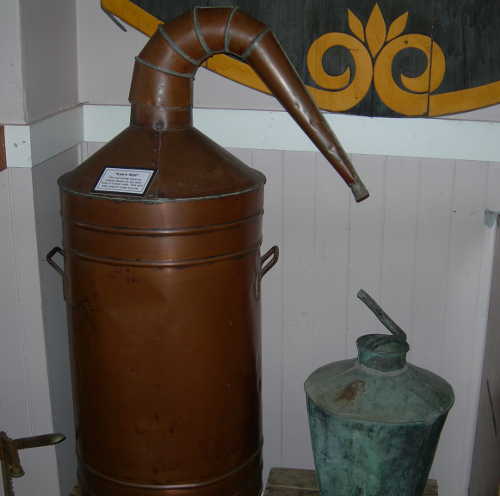
LAKE COUNTY, Calif. – The infamous apparatus known as a still was a popular item in days of yore.
During Prohibition, a still could sometimes be found, if one looked hard enough, camouflaged out in the woods.
The still which can be viewed in the Lower Lake Historic Schoolhouse Museum is known as “Lee's Still.”
The information card on the still reads, “The Lee family lived on Liberty Street on the west side of Lower Lake. This still was used to make brandy.”
A still made brandy through a high-heat process. The liquid was boiled, then, through a process of condensing, the cooling created a vapor.
A still can be used to create not only brandy, but other kinds of alcoholic drinks, like gin, as well as perfume and some types of medicines.
When illegal stills were used in America the drink was known as “moonshine.” When moonshine was prepared, the beverage wizards sometimes used corn for the potent brew which could turn out to be quite a strong, high-proof alcoholic drink.
Brandy and the distilling process to concoct it have been in evidence around the world since prior to the 15th century. The term “brandy” is a shortened version of the word “brandywine,” which was originally a Dutch term, brandewijn, meaning “burned wine.”
Considered a spirit, brandy is an alcoholic beverage produced through the process of distilling wine, and can hold a whopping 35 to 60 percent alcohol by volume.
Since brandy can be anywhere from 70 to 120 proof alcohol, it has traditionally been reserved as an after-dinner drink to be consumed in small amounts, most often in glasses called snifters.
Brandy has sometimes been aged in wooden barrels, often oak, or casks, and can obtain its glossy, amber-to-chocolate color from caramel additive, or simply through the aging process.
In the wine-making world brandy is often synonymous with Cognac, but that term is taken from the area of Southwestern France.
Long ago, brandy was distilled as a way to help it keep its flavor for long transports to various markets, and some sources make note of the distillation process being used as an aid to lower taxes, since they were levied by volume. Then, after it reached the market, water could be added back to the product.
Most brandies were produced through distilling wine from grapes so areas with a large viticulture region like those in Western Europe were where most brandies were produced.
Brandy is synonymous with “fruit brandy” when peaches or other fruit is used. It can be called “applejack” when apples are the main ingredient in the process of distillation, and “grain brandy” when grains are used.
Brandy has historically been popular in cooking meat sauces, adding distinctive flavors to soups, and for desserts such as holiday cakes, butters and puddings.
Using brandy as a fancy flambé in crepe Suzettes and cherries jubilee and set to light over other desserts gives a unique character to the meal.
Kathleen Scavone, M.A., is a retired educator, potter, writer and author of “Anderson Marsh State Historic Park: A Walking History, Prehistory, Flora, and Fauna Tour of a California State Park” and “Native Americans of Lake County.” She also writes for NASA and JPL as one of their “Solar System Ambassadors.” She was selected “Lake County Teacher of the Year, 1998-99” by the Lake County Office of Education, and chosen as one of 10 state finalists the same year by the California Department of Education.

 How to resolve AdBlock issue?
How to resolve AdBlock issue? 



